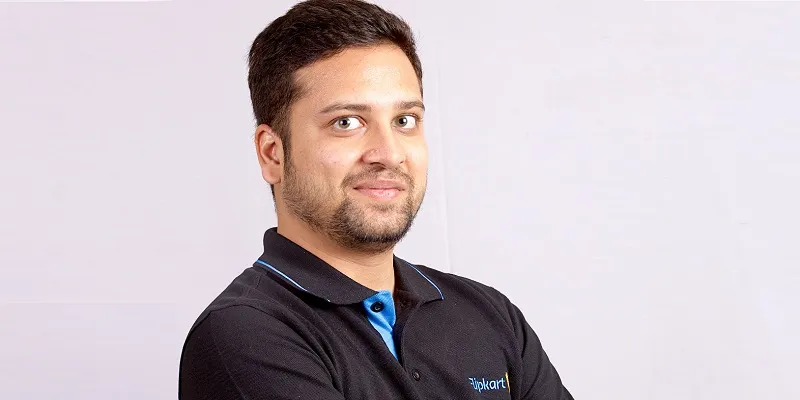Binny Bansal: Flipkart can fend off a 22-yr-old global giant buying market share
After a month of festive season sales, where competition between Flipkart and Amazon two peaked, Flipkart says it has the upper hand. In fact, the group — spanning Flipkart, Myntra, and Jabong — claims to have had the biggest sale in India's e-commerce history, crossing $2.5 billion sales run rate in fashion during October 2016. Sales on October 3 this crossed Rs 1,400 crore — the highest in single-day sales across organised retail in India. Among their sellers, 37 became crorepatis and 1,098 are now millionaires.
In an interaction with YourStory, Flipkart CEO and co-founder Binny Bansal talked about the team’s efforts behind the success. Edited excerpts below:

How do you feel about the overall performance of Flipkart in October?
We were focused on three categories which customers were expecting discounts on — smartphones, large appliances, and fashion. Across all these categories, compared to October 2014, we did 6x better in GMV and 5x better in units, in October 2016. Our overall sales in October is about 70–80 percent more than Amazon. Our strategy was not to focus on FMCG for numbers. There is obviously a limited amount of delivery capability. Our strategy was to maximise it through the three categories.
Why did you not include FMCG in your numbers?
When the customer is shopping, it’s not like, "I’ll buy some detergent." That is not what customers want [for the festive season]. They want new shoes, clothes, or a new smartphone or refrigerator. We are focused completely on what our customers want and how we can optimise overall sales by giving customers what they want.
From a GMV perspective, we have had a $2.5-billion run rate [for the Flipkart group including Jabong and Myntra]. That is 75 percent of online fashion.
What is your current GMV?
We talk about GMV only when we reach milestones. In categories like large appliances, our market share is double and more than our competitors for the month of October.
The more important point is that this wide lead establishes that Flipkart, a home-grown company — an Indian startup — can successfully fend off a 22-year-old global behemoth pouring in money to buy market share. This answers the question in everyone’s mind today: it shows that today or in the future, it is possible to take on global competitors and build a sustainable model with a right recipe of customer focus, local knowledge, and local innovation.
On the cost side too, we did quite well. Overall our spend in marketing and supply chain was just 30 percent of [what] Amazon [spent]. We did an innovative 360-degree campaign. Similarly, in supply chain, we have had a lot of learning from our past two years in terms of optimising cost end to end. Overall, we were able to do the whole of this October’s sale at almost the same cost as that of last October.
Are festive sales becoming more about marketing than about sales?
The whole event is about taking the industry forward. This is a marquee event for e-commerce. It gets a lot of new customers for e-commerce. A lot of customers who are already online shoppers start buying more categories [during the sale]. It’s all about driving e-commerce forward.
Compared to last year, how many more items were sold this year?
We do not reveal that. But compared to a regular day, we sold 10x more ACs, 12x more fridges, and 8x more TVs. We also sold 4.5 million smartphones in the month of October [this year], which makes us the biggest seller of smartphones across India, online or offline. We sold one in every five shoes sold in the country in organised retail, online and offline. Also, 35 percent of our customers opted for no-cost EMI. Our products were made more affordable, as customers had to pay much lesser.
What are your lessons for the next big sale?
We want to overall improve the end-to-end experience. We want to have much faster shipping time. This time we did better than last year. We delivered about 80 percent of high-value items in three days. Next year, we want to do it in two days. We want to deliver 70–80 percent of all products in less than five days.
So you’re not focusing on discounts next time?
No, the overall focus is on experience.
You mean logistics has overtaken payments in terms of priority?
Yes.
Talking about payments, how has your association with PhonePe app helped you with The Big Billion Day sale?
It’s still very early days. We are still building the whole experience around the payments’ product. It is in a very nascent [stage] right now. [We got 60% orders on CoD.]
How does this month’s sale help in your fund-raising efforts?
I think October was a big boost for e-commerce and for the startup ecosystem in India. We have raised enough funding in the past, and we are not in a hurry to raise any more capital.
So are you denying the reports on your talks with Walmart?
We keep talking to people all the time. We have done it in the past as well.
There have been reports about Flipkart doing food delivery. Do you plan to begin services like Snapdeal’s ticket-booking and Amazon’s video-streaming by collaborating with other apps?
On the delivery side, from an Ekart perspective, we are helping the current players with their deliveries in a cost-effective and timely manner. That is part of our Ekart business; it is transforming the logistics business in India. There will be no other tie-ups for now.







